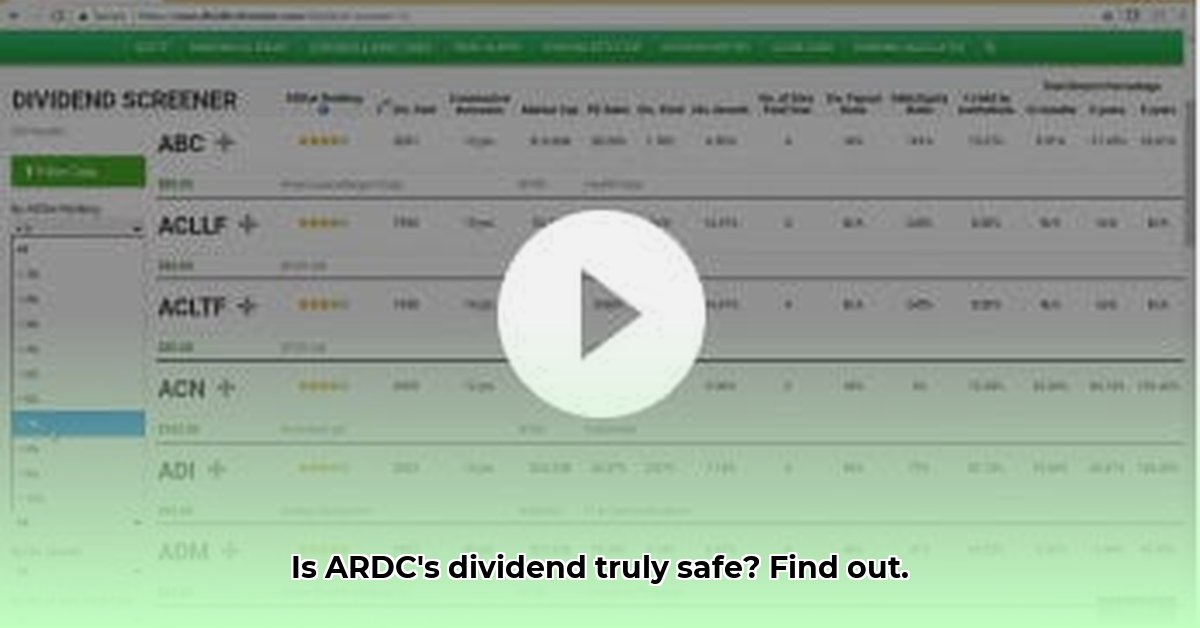
ARDC Dividend History: A Deep Dive into a High-Yield Investment
ARDC's stock currently boasts an attractive 9.16% dividend yield, a significant lure for income-seeking investors. However, the sustainability of this yield requires careful scrutiny. This review analyzes ARDC's dividend history, financial health, and inherent risks to determine whether this high yield is a sustainable advantage or a potential pitfall. We'll also offer actionable advice tailored to different investor profiles.
Is that 9.16% Dividend Yield Too Good to Be True?
The allure of a 9.16% dividend yield is undeniable. But is it sustainable? High yields often signal elevated risk. Before investing, a thorough examination of ARDC's dividend history is paramount.
Unpacking ARDC's Dividend Payments Over Time
ARDC has demonstrated a history of generally consistent monthly dividend payments. While the amount has fluctuated slightly, the frequency has remained largely unchanged. The following table illustrates this pattern:
| Year | Monthly Dividend (USD) | Notes |
|---|---|---|
| 2022 (Sep-Dec) | $0.1025 | Lower payouts compared to other periods |
| 2023 (Feb-Mar) | $0.1075 | A slight increase from the previous period |
| 2023 (Aug-Jul) | $0.1125 | Another small increase |
| 2024-2025 (Jan-Jan) | $0.1175 | Highest consistent payout so far |
While consistency is positive, these minor fluctuations warrant investigation into the underlying causes. Understanding these variations is crucial for assessing future dividend prospects.
The Missing Piece: Understanding the Payout Ratio
A critical piece of information is missing: ARDC's payout ratio (the percentage of earnings paid out as dividends). Without this key metric, evaluating the sustainability of the dividend becomes highly speculative. The absence of payout ratio data significantly hampers our analysis.
A Deeper Look: ARDC's Financial Health
The lack of readily available (meaning not included in the original article) detailed financial information, such as cash flow, earnings, and debt levels, prevents a comprehensive assessment of ARDC's financial health. This information is vital for determining the long-term sustainability of the dividend. Further independent research is highly recommended.
High-Yield Investments: The Risks We Must Acknowledge
High-yield dividend stocks inherently carry greater risk than lower-yield counterparts. These investments tend to exhibit higher volatility. Economic downturns or company-specific challenges can easily lead to dividend reductions or even suspensions. The higher the yield, the greater the potential for loss.
Strategies for Investors: Advice Tailored to Your Goals
Investment decisions should align with individual risk tolerance and investment horizons.
Step 1: Define Your Investment Horizon:
- Short-Term (Under 1 year): Proceed with extreme caution. Diversify holdings extensively and closely monitor ARDC's financial performance. Be prepared for potential dividend reductions or suspensions.
- Long-Term (3-5 years or more): Conduct thorough due diligence, which includes obtaining the missing data. Consider not just the dividend yield but also the company's overall growth potential and its risk profile. The investment should only be a component of a diversified portfolio.
Step 2: Assess Your Risk Tolerance:
- Risk-Averse: Avoid ARDC or limit investment to a very small portion of your portfolio.
- Moderate Risk: Invest cautiously, acknowledging the potential for significant price swings and dividend reductions.
- High Risk: Consider ARDC as part of a diverse portfolio, but maintain close monitoring and be prepared for potential losses.
The Bottom Line: Proceed with Caution and Conduct Thorough Due Diligence
While ARDC's dividend history reveals some consistency, the absence of crucial financial information, such as the payout ratio, raises considerable concern regarding the sustainability of its high yield. The high yield is certainly enticing, but a comprehensive analysis of ARDC's financial health is crucial before investing. Diversification is paramount, and investors should only invest what they can afford to lose. Independent research should precede any investment decision.